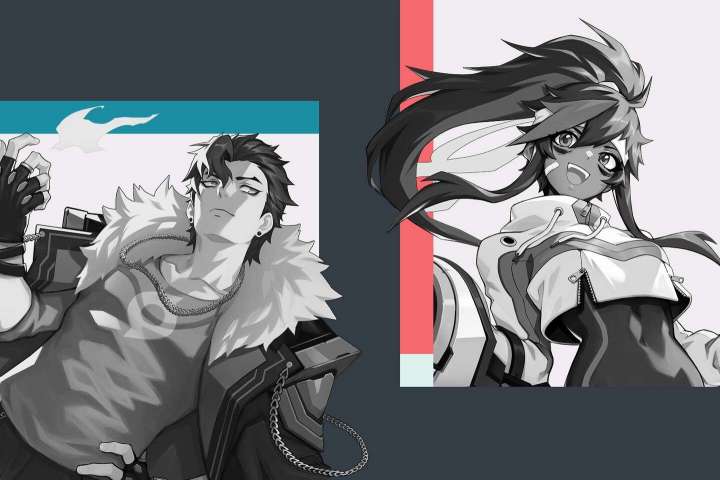Before Dax Andrus and Richard Henkel co-founded Odyssey Interactive, they were working together on “League of Legends” and “Teamfight Tactics” at Riot Games. There, the pair learned about the fundamental traits of a successful competitive game by working on one of the biggest esports franchises in the world. The first: A game should be easy to pick up but reward mastery with deep, under-the-hood mechanics.
The ‘Omega Strikers’ pitch is ‘gladiator hockey.’ That’s just the start.

The second is the mantra that Odyssey Interactive was founded upon: accessibility.
Odyssey Interactive’s debut title, the sports brawler “Omega Strikers,” is aiming to be the most easily playable game on the market. The studio strongly believes in being platform agnostic, launching “Omega Strikers” as a free-to-play title on PC and mobile with console versions currently in development. This extends to the game’s competitive philosophy, too. Whereas most competitive games divide players into different ladders based on platform, “Omega Strikers” players all compete in the same ladder.
Henkel said that one of the studio’s objectives is to entice the rising generation of gamers who have been raised on touch screens and mobile devices by treating them as a “first class citizen.”
“We would much rather have players make a decision to play the game based on the game’s merits and not like, well, is it available on my platform?” Odyssey Interactive CEO Henkel told The Washington Post. “Is it available in the control scheme that I like?”
To that end, “Omega Strikers” offers a generous array of input options. PC players can choose between using a mouse and keyboard or joypad, both of which can be remapped. Mouse and keyboard users can move their characters around the arena using either the keyboard (WASD configuration) or mouse (MOBA configuration). There are also several toggles such as an ability indicator and strike indicator which give more precision over attacks at the expense of speed.
Another window into the game’s mission of accessibility is the presentation. The premise behind “Omega Strikers,” developer Odyssey Interactive’s first game, is immediately obvious to anyone who’s been inside an arcade. A 3-on-3 game with a diverse cast of anime characters on a giant air hockey table fight for control of an enormous glowing puck. The elevator pitch of superpowered athletes playing gladiator hockey pretty much writes itself.
Odyssey Interactive president Andrus said that “Omega Strikers” originally started off as a straight-up action game that went through several prototypes. But adopting the sports angle allowed the team to hit two seemingly contradictory objectives: adding the Core (the game’s giant hockey puck) made the game easier to understand, and also introduced an extra layer of mechanical complexity.
“The fact that you can knock out other players means you have to be thinking about a balance between playing a PVP fighting game and a more sports-oriented, score the ball focus kind of game like FIFA,” said Andrus, president of Odyssey Interactive.
That’s where the Strikers, the game’s playable characters, come into play. Each Striker has a unique moveset of special abilities which can be used to move the Core or bash enemy Strikers. Taking damage increases a Striker’s stagger bar, making it easier to knock them off the field and temporarily remove them from play. Strikers also grow stronger throughout the course of a match as they accumulate experience points which is accelerated by performing playmaking actions such as scoring goals, making saves, knocking out enemies and so forth.
The Strikers themselves are also designed to be visually distinguishable. For example, you can tell that Atlas is a defense-oriented Striker by his heavy armor and tall, broad-shouldered frame. X, another Striker who is even bigger than Atlas and eschews armor for a flashy leather vest that does little to cover his numerous battle scars, is clearly a divebombing brawler. Each team has two forwards and a goalie but both roles can be played by any Striker.
The game’s sports angle also lends to a smooth viewing experience, which has been a growing design consideration for developers seeking to create titles with esports viability. Historically, competitive video games have been notoriously difficult to watch because the most popular titles were never intended to be watched by fans. In games such as “Counter-Strike: Global Offensive” or “League of Legends,” the camera constantly tracks different players as they move across disparate parts of a large map doing a range of distinct actions. This can make for a confusing and frustrating viewing experience for anyone who doesn’t play the games in question.
In “Omega Strikers,” the objective is immediately recognizable and easy to follow: hit the Core into the other team’s goal and take down anyone who gets in your way. Moreover, the camera doesn’t need to jump around because the entire game takes place in a single shot. That makes it easy to watch and ensures that spectators never miss a big play because the camera was elsewhere.
All in all, Odyssey has laid out a solid plan to invest in a future demographic of gamers while still courting those who are turned off by mobile games. But “Omega Strikers” is also a foundation for much bigger goals. Odyssey has already started development on its second game, which will feature the same characters as “Omega Strikers.” Similar to how Riot used its “League of Legends” characters for “Teamfight Tactics” and its upcoming fighting game code-named Project L, Odyssey intends for its Strikers to reappear in all sorts of new games and media.
“They can be the star of their own video game, they can be the star of their own anime if we choose to make it one day,” Andrus said, laughing. “Fingers crossed, fingers crossed.”






